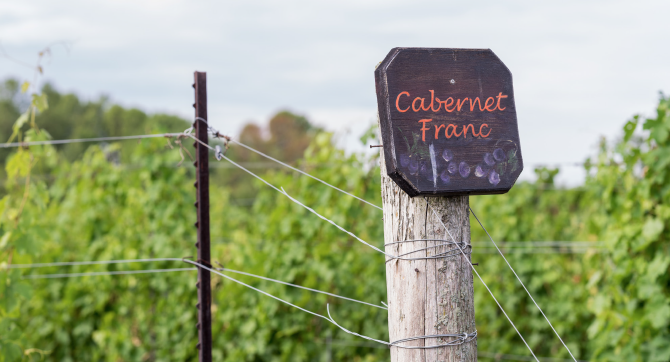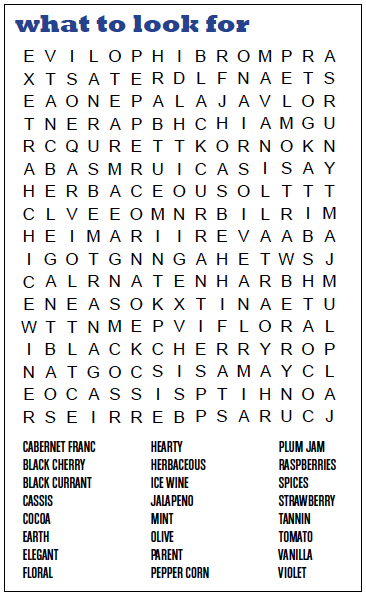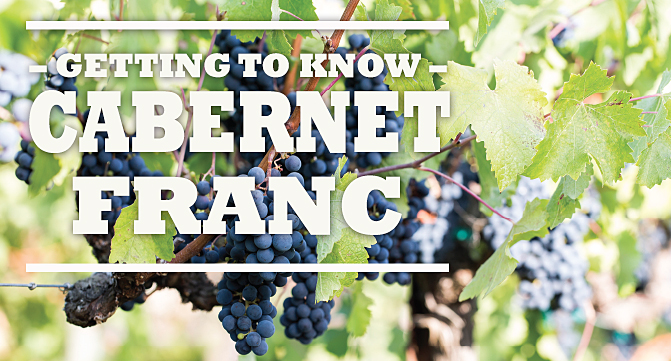Getting to Know – Cabernet Franc
Is Cabernet Franc the new hot ticket varietal for California Wine Country? Its easy-drinking, food friendly and soft nature may prove it to be a good option.
Cabernet Franc has an elegant and uplifting structure that offers lovers of red wine an alternative to some of the heftier red wines produced by the other Bordeaux and popular California varietals which include Cabernet Sauvignon, Merlot, Petit Verdot and Malbec with a bottle price that doesn’t break the bank! Cabernet Franc is the quiet parent of the popular, powerful and bold Cabernet Sauvignon and mild, easy-going Merlot, as well as Malbec and Carmenère. It’s origins lie in the Basque Country of France in the western Pyrenees and typically it is used as a blend in some of the world’s most famous Bordeaux wines. Cabernet Franc historically has shown it’s greatest strength and character as its own varietal in the wines of France’s Loire Valley. It is here were it was originally known as Bouchet and later became more recognized by the regional names of Chinon and Bourgueil.
It took at least 100 more years before plantings of Cabernet Franc started to appear in the RightBank of Bordeaux in the regions of Saint Emilion and Pomeral where the limestone soils proved to be a good expression and hold great potential for the grape. Though Cabernet Franc has proven most successful as a single varietal in the Loire Valley and United States, it is also planted in many other wine producing countries including Italy, Chile, Spain, Australia, New Zealand, Hungary and Croatia. In most of these regions, as in Bordeaux, it is used as a blending grape along with Merlot and Cabernet Sauvignon, but several wine growing regions including the cooler climates of Hawkes Bay, New Zealand and Hungary produce top quality and distinguished single varietal Cabernet Franc.
In the case of Italy which is the second largest producer of Cabernet Franc, the grape is not indigenous to Italy and, therefore, declassified out of the Italian DOCG rating system. With no formal classification, these wines are included under the reference of “Super Tuscans” and have gained notoriety as superior expressions of the grape.
Cabernet Franc continues to grow in popularity these days and is one of the world’s top 20 most planted grape varieties. Because Cabernet Franc is one of the parents of Cabernet Sauvignon, there are a lot of similarities between the two grapes.

get the dirt
Understanding terroir and its influences
Cabernet Franc is a hearty vine with a relatively easy growing nature. It’s better suited to cooler climates and cooler vintages. It buds and ripens a bit earlier than Cabernet Sauvignon and can be harvested earlier before inclement weather damages other vines. Cabernet Franc can often be distinguished by the terroir in which it is grown, as well as the clone that is planted. It is more prone to genetic mutation than Cabernet Sauvignon and generally, can adapt to a wide range of vineyard soil types. It seems to grow best in chalk and sand, however. The grape can show interesting variety, as well, when grown in the Loire Valley where the terroir differences are distinguishable.
The variety also really showcases well in the North Eastern United States. Cabernet Franc thrives quite well in the regions of California, Washington State and Oregon where the fruitforward flavors of ripe strawberry, black cherry and plum jam are more prevalent. It has also proven quite successful in the cooler growing regions of Long Island and Finger Lakes, New York and in Ontario where it the grape makes an excellent sweet, high-acid wine known as ice wine.

swirl, sniff, sip, savor
How to identify Cabernet Franc in the glass
Though Cabernet Franc is related to Cabernet Sauvignon and is often grown alongside its offspring as an “insurance policy” against the later-ripening Cabernet Sauvignon, there are other differences between the grapes that can be determined by sight, nose and taste. Cabernet Franc is a deeply colored, blue-black, thin-textured grape that produces a medium-bodied wine that is a bit more red in color and lighter viscosity than Cabernet Sauvignon. On the nose softer red fruits of strawberry, raspberries and black currants come through nicely, as well as plum, violet flowers, herbs and a bit of graphite-like spice when ripe. It is possible to detect more vegetal notes of green pepper and olive when young.
On the palate, Cabernet Franc has a higher acidity and lower tannin structure than it’s offspring Cabernet Sauvignon. It will also offer a smoother mouthful and texture. Depending on where it is grown, tastes will vary from bursts of tomato, sweet pepper and sour cherry to black cherry, cocoa and red pepper flakes to strawberry, raspberry and roasted jalapeño. Overall, this varietal has a nice blend of fruit, earth, spice and floral components.
What’s in a glass
Would wine in any other glass smell as sweet?
Like it’s Bordeaux family members, Cabernet Franc is best enjoyed in a Bordeaux wine glass with a larger bowl shape which is ideal for a full-bodied wine. The generous size of the glass allows for proper aeration of the wine delivering more aroma compounds to the nose. The bouquet of the wine can fully develop and the shape of the rim directs the flow of the wine to the front of the palate to enhance the fruit-forward flavor and allow the fragrance of spice and flower to open and offer a smooth finish.
how to pair like a pro
Cabernet Franc is a very popular food wine. Given its range of phenolic compound characteristics, there are many great ways to match Cabernet Franc with food and it is a very good choice for Greek and Mediterranean dishes, as well as Italian and Middle Eastern cuisine.
The wine’s natural herbaceous notes make it a terrific option for foods with real herbs in the dish like oregano, thyme, rosemary, sage, coriander, red pepper flakes and black pepper. Its racy acidity and lower tannic structure give the back drop to pair nicely with tomato-based dishes and vinegar-based sauces like BBQ.
Cabernet Franc also makes room for lush bean and vegetable pairings for the vegetarians in the house. It is a smooth companion to black lentils, red beans, pinto beans roasted red peppers, mushroom, tomato, eggplant, leeks, spinach, sun chokes, arugula and olive. For your meat lovers, Cabernet Franc holds its weight and pairs beautifully with game like roast chicken, pork, beef, duck, sausage, lamb, veal, as well as some hearty fish dishes. Grilled salmon or smoked white fish with tomato sauces work well with the light-bodied nature of the wine as well as the oak characteristics that give it some smoke and spice undertones. The grape will even blend well many hard cheeses, as well as some soft cheeses like Camembert, Feta and the favorite French regional Goat cheese. In the French Bistros, Cabernet Franc is a perfect match to Quiche Lorraine, Steak Frites and Roast Chicken.


